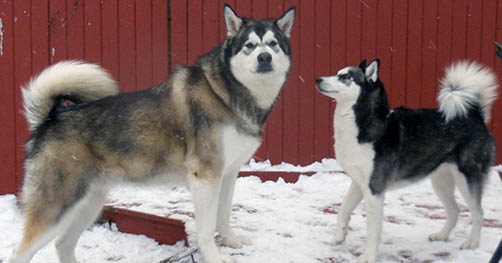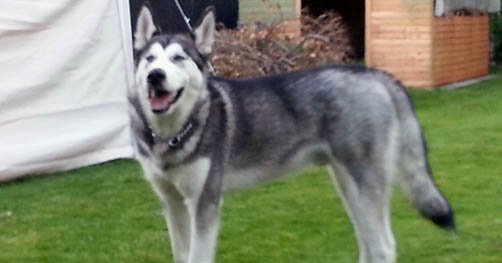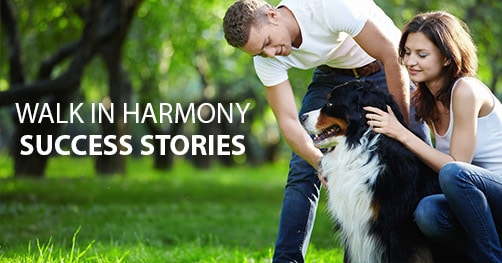Success Stories: How Our Students Are Training Their Dog To Walk On A Loose Leash (And Stop Pulling On The Leash)
In my first article in this series on training your dog to walk on a loose leash without pulling, I shared my unique four-step training process. In my second article I discussed the five most important reasons you should train your dog to walk on a loose leash.
In this article I will share some of my students’ success stories. You’ll see that it’s possible to transform your dog’s walking behavior, no matter your circumstances. And by the end of the article you’ll be motivated to take action yourself. If others can do it, so can you.
I would like you to meet two dogs, Balto and Makita, belonging to one of my students.

Balto and Makita are large dogs that weigh over one hundred pounds each. Their owner, Luann, was having a difficult time walking them together because they were easily distracted. But with the help of the self-control training games inside my Walk In Harmony Game Plan, Luann was able to teach her dogs to focus on her.
Here is what Luann said after completing my program:
[order_box style=”4″ alignment=”center”]“Because of the Walk in Harmony Game Plan, I can finally walk both of my dogs at the same time and go to parks, beaches and even hiking with them. I have a 3 year old small Siberian Husky and 7 month old 100 pound Alaskan Malamute and they both are natural pullers when walking on a leash. I had to take them on walks separately because of the pulling and being distracted so I only took them one at a time up and down my block. After using this program on both dogs I can now take them on walks together and go to parks and beaches, hiking and anywhere I want.
This program is a fun-filled positive, motivating, and bonding program for both owner and their dog. The Walk In Harmony Game Plan is user friendly, day by day steps which makes it easy to understand, and very precise easy to follow videos.”
[/order_box]Building your dog’s self-control is vital. It will teach your dog to think twice before running after something like a squirrel or another dog. And the best thing is that you can start building your dog’s self-control in only five minutes and in the comfort of your own home.
For example, my popcorn training game teaches your dog to ignore a pile of popcorn on the ground. Although you’re not likely to see this while walking your dog, the purpose of the training game is to build your dog’s tolerance for distractions by focusing on you instead of the distraction. The game serves as a blueprint you can use to train your dog to overcome any distractions including a dog barking, a squirrel running, or something on the ground.
If you haven’t yet tried my popcorn training game, here is a sample video showing exactly what to do:
Meet another student who has gone through my Walk In Harmony Game Plan: Lisa also struggled because her dog Doodle was easily distracted. But her dog reacted differently than Luann’s. Instead of just pulling on the leash, Lisa’s dog would also become overly excited and bark uncontrollably at the distractions. Lisa found herself in a quandary: How could she get her dog to stop barking?
Like Luann, Lisa also found the self-control training games to be extremely beneficial. Here is what she wrote to me after completing the program:
[order_box style=”4″ alignment=”center”]“My dog is a 9 month old Doodle who was very easily distracted by birds, cats, other dogs and especially squirrels. The walk was a constant struggle because he would zone out at the sight of any of these. He would become extremely excited, pulling and barking and then remain in that state of excitement for the rest of the walk. We had an AHA moment where I understood how to apply the ‘ It your choice’ principal to the beginning of the walk.”
“Some days we don’t walk at all we just practice going back and forth up the driveway working on self-control and paying attention to me. This has greatly improved our walk. He is much better when passing dogs now. He still gets really excited with squirrels but he seems to recover from them a little quicker so that I get his attention back. He is still a work in progress and we have a ways to go yet but I feel more confident now with the tools I learned from Jean’s program. I have always used positive reinforcement when training Doby but the addition of the ‘it’s your choice’ component has made a huge difference.”
[/order_box]If you’re wondering what Lisa means by “It’s Your Choice,” it’s the process of teaching your dog that it has a choice. Instead of punishing your dog for bad behaviors like pulling on the leash or barking, I teach my students to offer their dogs a choice. If their dog makes the right choice, such as paying attention to them, walking next to them, or ignoring distractions, then they reward it.
This is the opposite of what many traditional dog trainers teach. Many dog trainers will have you punish your dog for bad behaviors by either pulling sharply on the leash or using a pain-inflicting device like a choke or prong collar.
There’s none of that in my program. Instead, my program requires you to think creatively and to understand what goes on in your dog’s mind. As you offer your dog choices, your dog will learn to think about what it’s doing, and over time your dog will learn to look for ways to please you, even when you’re not actively asking it to do anything.
That is how I teach my students to train their dogs, and that ultimately leads to the happy, well-behaved family dog they’re proud of.
Now I’d like you to meet Chester, another dog that has gone through my Walk In Harmony Game Plan with her owner Marianne.

Marianne knows a thing or two about dogs and is very experienced with owning different breeds. But before she enrolled in my program she had trained her dogs using the traditional methods I mentioned above that are focused on punishments instead of rewards.
But Marianne was looking for a better way to train her dog to walk on a loose leash. She wanted her dog to pay attention to her, to walk at the same pace with her, and to respond to her body language.
Here’s an excerpt from a letter she wrote me after going through my Walk In Harmony Game Plan:
[order_box style=”4″ alignment=”center”]“Jean Cote’s Walk In Harmony Game Plan was certainly one of the BEST investments I have paid for – no classes, no fuel costs and no ‘waiting’ around to ‘do my turn’!
Jean Cote has changed my perspective on training and I am much more realistic in my expectations. Having had MANY dogs including Boxers, and bred Westies I thought I had done pretty well. Jean Cote has given me a much faster and patient methodology in training and with my latest (18 months at start of training) Chester – a Husky cross Alaskan Malamute, weighing now 6 stone+, it has been so rewarding for both of us in learning to ‘talk’ and ‘respond’ to each other – particularly as Chester is my ‘soul mate’ and just wants to ‘be’ with me and please me!”
[/order_box]I will be honest and say that her letter left me a little teary-eyed. There’s nothing better than making a difference in my students’ lives and seeing how much their relationships with their dogs blossom as a result of my training methods.
That is why I’m so passionate about this subject. It’s not just about training your dog to walk on a loose leash or to stop pulling. My ultimate goal is to give my students the tools and strategies to train their dogs to do anything they want them to do.
I believe the more time you spend interacting, training, and having fun with your dog, the less likely you are to give up your dog. There’s a crazy statistic from the ASPCA that 3.9 million dogs in the United States are abandoned to shelters every year. And of that number, 30 percent will be euthanized.
That is a staggering statistic, and it’s only for the United States. And so it’s my duty as a professional dog trainer to promote these training methods because I know how much they can improve the quality of life for both owners and their dogs.
I would like to thank you for reading this three-part series, and if you would like to continue your education I would be pleased to welcome you inside my “Walk In Harmony Game Plan.” I’m always excited to meet and greet new students, and I look forward to reading your success story.


What s great series on getting my dog to be a better walking partner. She is still a work in progress but we see improvements every day. Thanks Jean.